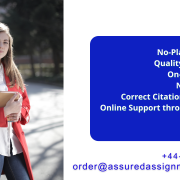Final Group Report (50%) – Learning outcomes3 & 4
The major project in this unit is to develop a marketing plan for expanding a product or service into a new market (or ‘host’ country). The students are free to choose any product/service from any country they like, as well as any ‘host’ county or new market they like.
Students will form groups of up to 5. There is no minimum limit for group size, but the assignments will be assessed based on what can be expected from five students working together on this task for the whole semester. Individual adjustments of marks will not be considered, as all students are expected to contribute to every section of the report. Groups will be formed in Week 3 tutorials.
Students are strongly advised to choose the origin of the product and ‘host’ country based on the expertise in the group. As such, culturally diverse groups may have an advantage. The word length is maximum 3,000 (excluding Contents page, Executive Summary, List of References and Appendices).
Note: This is an advanced third year unit. A sound, reasonably developed argument as well as accuracy in referencing, spelling, grammar and punctuation are of vital importance for this assignment. Students that do not meet these requirements may not pass this assessment.
Group Report Assessment Details
Each group will take on the role of consultant to an organisation wishing to extend their operation into a new international market with a further focus on a specific market segment within the new market in which they do not currently operate. This can be a local organisation wishing to go overseas OR a foreign organisation wishing to enter your home country. The group may choose to focus on a product or a service. These products could be marketed to either a consumer or business-to-business market.
Each group will submit a written report. The research is to consist of secondary research data only. Chapter 6 of the textbook may provide you with some ideas for sourcing secondary research information. Demonstration of research skills is important; All reports must cite at least twenty (20) different published journal papers or relevant secondary sources (excluding web-based information). Web-based information can be used in addition to these published references, but only 10% of references can be web-based.
The report must include an explicit motivation – e.g “PowerAde is currently ranked no. 2 worldwide. Brazilian consumers spend X mill $ on sports drinks, yet PowerAde is not in the Brazilian market”. ALL FACTS PRESENTED MUST BE REFERENCED.
The report must include an executive summary, introduction, conclusions and recommendations. Secondary sources of evidence must be identified, used and referenced as supporting evidence for ALL of your recommendations in EVERY section of your report.
Submission
No hardcopies are needed for this assessment. All assignments will be marked and handed back electronically through the assessment Dropbox link on Collaborate. Submit your assignment to the Turnitin link on VU Collaborate by the end of the Friday following your lecture in week 11. Work submitted after the due date, without an extension granted or the relevant documentation provided will be regarded as submitted but will attract a zero mark.
What to include in your report
The report must consider the following issues in relation to your country and product (the sequence of these issues can be changed to suit the context of the individual project):
| Description and justification for country recommendation |
| This section should include a description of the nature of the product or service and an environmental justification for country recommendation. Briefly describe the nature of the product or service and why you are recommending this country for its expansion. Your rationale may include favourable factors in the external environment within the recommended country and its marketplace for this product or service e.g., external environment factors such as economic; technological; political/legal; cultural or social; geographic; and other distinguishing characteristics of the external market. |
| Competitor Identification |
| Briefly identify the competitors for your product or service. Competitive factors such as nature of the market and demand for the product; market characteristics such as size of the market; recent growth trends; and develop a scenario of how the industry structure might change over the next five years. Supporting evidence should include market share statistics, an overview of the competitors’ products and other distinguishing characteristics of the competitive environment. |
| Cultural profile |
| Describe the culture in your ‘host’ country using Hofstede’s and/or Hall’s theories. Outline the key features of the culture and its values, and comment on how that may affect their decisions as consumers of your product. Also, contrast and compare the host country culture with the country your product comes from. The outcome of this analysis should be the basis for the strategic recommendations – (Refer below). |
| Country-of-Origin, foreign and domestic consumer predispositions |
| The success of the product in the foreign market may depend on consumers’ attitudes towards the origin of your product/service (includes Country-of-Origin, Consumer Ethnocentrism, Consumer Animosity, Consumer Disidentification and Consumer Affinity). Analyse these effects. The outcome of this analysis should be the basis for the strategic recommendations. |
| Market Segmentation, Target Marketing and Positioning |
| For the recommended country and your selected product or service, discuss how the market for your product can be segmented and from these segments recommend the target market(s) for the expansion of your product/service. You further need to outline details about their associated segmentation characteristics and profile such as their demographics, geographics, psychographics, benefits sought from the product, behavioural patterns for the product or service category, media preferences and media infrastructure for this market. Examples of target markets are families, seniors, youth, gender-based, yuppies, selected urban or rural markets, or combinations of some of these.
Secondary sources of evidence must be identified, used and referenced as supporting evidence for your recommendations about this market, how it can be segmented and the attractiveness of your recommended target market(s). |
| Market Entry and Expansion (e.g., licensing, exporting, joint ventures etc.) |
Recommend marketing strategies for the expansion of your product or service into this country and for your previously identified recommended target market(s). In particular include:
|
| Strategic recommendations |
| Make recommendations to senior management based on the above analysis. Your recommendations should include the international marketing mix and other international marketing related factors. The following factors could be discussed: Positioning, COO, CE, CAn, CD, CAf, product modification, distribution, pricing, and culturally adapted promotion. Your marketing strategy recommendations should be supported by relevant secondary sources of evidence, which must be identified, used and referenced.
Your analysis above must be discussed and reflected on when you outline your strategy recommendations, which means that is it meaningless to assign this part of the assignment to one student. The group needs to discuss this part together – in due time – based in the research you have done above. This part cannot be complete before all the other sections are done. |
Final Group Report Marking Rubric
| Topic | Very Good | Good | Satisfactory (met min. requirements) | Inadequate | Not addressed at all |
IDENTIFICATION (10%)
|
|||||
COMPETITION (10%)
|
|||||
CULTURAL PROFILE (10%)
|
|||||
COO (10%)
|
|||||
S-T-P (10%)
|
|||||
MARKET ENTRY AND EXPANSION (10%)
|
|||||
STRATEGIC RECOMMENDATIONS (20%)
|
|||||
ACADEMIC SKILLS (10%)
|
|||||
PROFESSIONAL STANDARD (10%)
|










